Copyright © University of Cambridge. All rights reserved.
'Arclets Explained' printed from https://nrich.maths.org/
Show menu
The Arclets problem set in September 2002 produced some very interesting and inspiring work from Madras College. This short article gives a flavour of the way that Sheila, Shona, Alison Colvin, Sarah, Kathryn and Gordan tackled the problem.
Each of the following shapes is made from arcs of a circle of radius r.
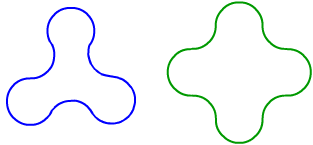
What is the perimeter of a shape with $3$, $4$, $5$ and $n$ "nodes".
What happens when $n$ is very large?
Explain the relationship between your answers and the perimeter of the original circle
Here are arclets with $3$, $4$ and $5$ nodes:
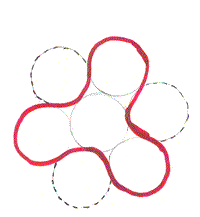
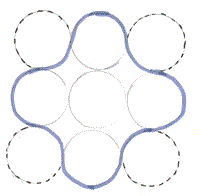
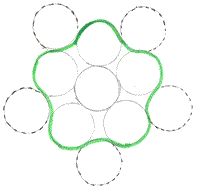
3-node solution
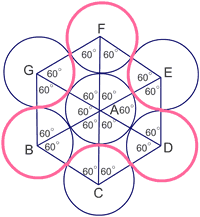
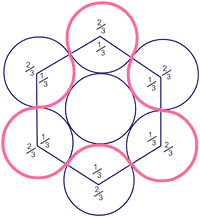
The angles at the centre of the inner circle are $60^{\circ}$
So the angles at the centre of the outer circles are $120^{\circ}$ and $240^{\circ}$ ($120^{\circ}+240^{\circ}= 360^{\circ}$.
We can therefore divide each circle into a $1/3$ ($120^{\circ}$ out of $360^{\circ}$) part and a $2/3$ ($240^{\circ}$ out of $360^{\circ}$) part.
The perimeter of the arclet is made up of 3 "inward" arcs of $1/3$ of the circumference and 3 "outward" arcs of $2/3$ of the circumference.
4-node solution
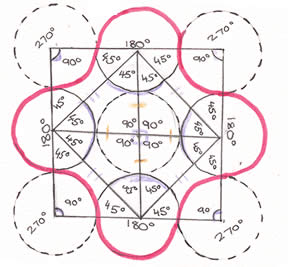
The inward arcs are $1/4$ of the circumference ($90^{\circ}$ - there are 4 inward arcs.
The outward arcs are $1/2$ of the circumference (4 lots of $45^{\circ}$ - there are 4 outward arcs.
5-node solution
Because the inner circle is surrounded by five outer circles there are 5 angles - all of $72^{\circ}$ at the centre.
Using the properties of isoseles triangles the outward arcs are $2/5$ of the circumference and the inward arcs are $1/5$ of the circumference.
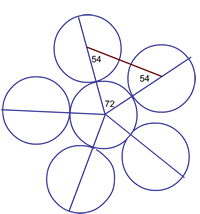
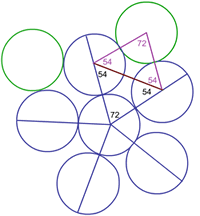
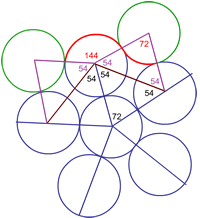
An image of part of the work Sarah, Kathryn and Gordon did to find the perimeter of the 5-node arclet is shown below
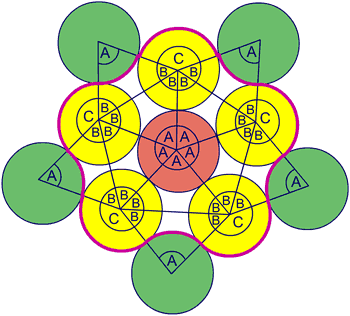
6-node solution
Scanned diagrams showing the work of Sheila, Shona and Alison to find the perimeter of a 6-node arclet:
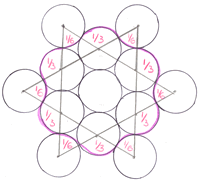
Finding the perimeter of the N - node arclet
We know that these are the equations for the perimeter of 3, 4, 5 and 6 node arclets:
|
Number of nodes |
3 | 4 | 5 | 6 |
Perimeter |
$ \quad 3\times 2 \pi r = 6 \pi r \quad $
|
$ \quad 3\times 2 \pi r = 6 \pi r \quad$ | $ \quad 3\times 2 \pi r = 6 \pi r \quad $ | $ \quad 3\times 2 \pi r = 6 \pi r \quad$ |
If we substitute $N$ for the node number we get (in every case):
This is based on the fact that the angles at the centres of the circles will be $1/N$ of a full turn.
If $N$ is very large the node shape begins to look like a circle:
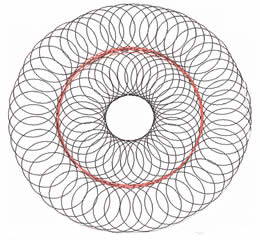
In other words. No matter how many nodes the perimeter will always be 3 circumferences.